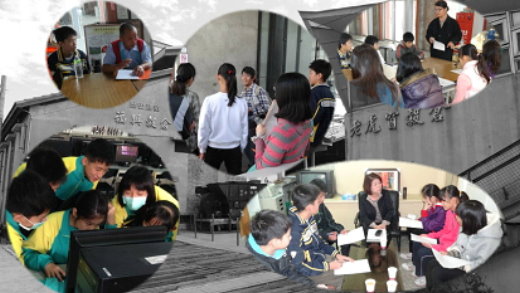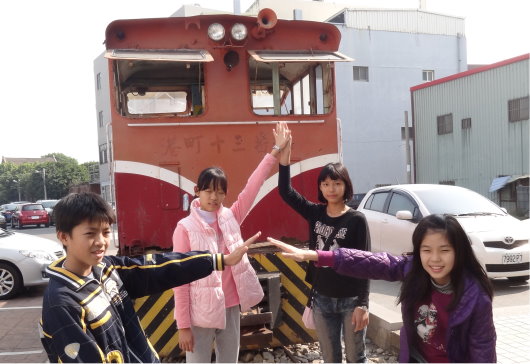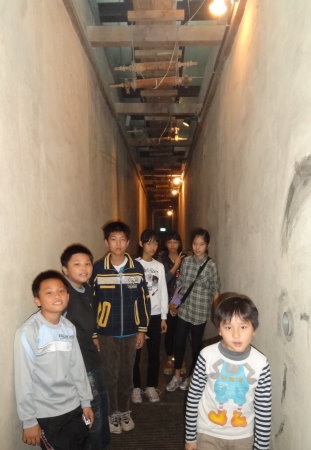| |
|
|
Project Description
›››
Project Elements
Project Elements
1. How did your activities and research for this Cyberfair Project support
standards, required coursework and curriculum standards?
The primary goal of the Twelve-year National Fundamental Education is to
enhance basic competence and nurture civic literacy of the common citizen.
Through our study of the Fuxing Silo not only did we incorporated the
subjects of history and language into the study, we also gained a better
understanding of the development of our hometown Changhua Plain. We’ve
learned to love it even more. Our interview with the interviewees is a
comprehensive learning of language arts, history and even economics. These
are knowledge and skills which we couldn’t learn from our textbooks and
which also fulfilled the “Stimulate the students to have the ability of
active research” and “promote cultural learning” aspects of the Grade 1-9
Curriculum Outline.
|
Language |
Through the writing up of reports, afterthoughts, project web
page, and project narrative, we learned to choose word
carefully. We also learned to edit and organize manuscripts,
transcript, and other information. We were able to conduct
interviews; a skill which involved the listening, speaking,
reading and writing skills of language arts. |
|
Social studies subject |
Team members had to have a good understanding of the functions
and supports of our society’s government agencies. Some of the
information can be found in our social studies text, but a lot
of it we had to research and find out on our own. |
|
Comprehensive activities |
Team members had to learn to communicate and tolerate other
group members and most importantly of all, teamwork. |
|
Arts and humanities subject |
We saw the art of decorating an exhibition. The ability to
decide which art piece to keep and sacrifice is very important. |
|
Environment Education |
From the rise and fall of the Fuxing Silo we learned to respect
history. We learned the influence the early social society, and
agricultural background had on the local community.
While getting to know Fuxing Silo, we gained a better
understanding of Taiwan’s early Green Building. Although it
wasn’t a time of great technology but the people of the time
were able to build an architecture which fulfill the natural
concept of an eco-friendly building. |
|
Information |
Through new information technology techniques we learned to
build a web page, and we also learned to store and retrieve
information using new information technology devices. |
Through the making of the Cyberfair project, Teacher Hung-ying Chen taught
us to use PhotoImpact, an image processing software and FrontPage, a web
page making software. All the typing and editing improved our word
processing skills. We also learned to use various search engines for
researches. The things we learned really implemented the information
education aspect of the curriculum.
Throughout the making of the project, we divided work and
worked hard. Although it was a lot of hard work, we encouraged each other.
From it all, we learn to truly understand the concept of “Team Work”.
2. What information tools & technologies did you used to complete your
Cyberfair project?
|
Applicable Tool |
Function |
|
Desktop, Notebook, Tablet |
Word processing, Uploading information, Web page making |
|
Digital camera |
Take photos, record activities, enhance web page presentation |
|
Recording pen |
Record Interviews |
|
Network system |
Internet Explorer, Google Chrome Web browser, information
inquiry, upload information from a smart phone, FaceBook to
communicate |
|
USB Drive |
Store Information |
|
Printer |
Print out documents |
|
Telephone |
Contact interviewees |
|
Applicable Software |
Function |
| Microsoft Word |
Word processing |
| Internet Explorer |
Data research, information download and upload |
| Ulead PhotoImpact |
Image Processing |
| Microsoft Frontpage |
Make web pages |
3. In what ways did you act as "ambassadors" and spokespersons for your
Cyberfair project both on-line and in person.
To learn more about Fuxing Silo, we began by searching vigorously at the
library, the Cultural Affairs Bureau and through the internet to gain more
knowledge about the history, geography and culture of Fuxing Township. Then
we got in touch with Mr. Wu-lang Cheng who is a Lukang cultural worker to
give us a guided tour of Fuxing Silo. By seeing it in really life, we were
able to have a better understanding of the function of Fuxing Silo and its
place in history.
Later we interviewed former Magistrate of Changhua County, Mrs. Chin-chu
Weng who is a promoter of the local culture, a member of regional authority
and the hand behind the restoration of the Fuxing Silo. Senior volunteer,
Mr. Lin spoke endlessly of the past as we see the passion that blazed in his
eyes. It’s a passion which we may not easily comprehend. Director of Fuxing
Farmers’ Association, Mr. Jun-ji Shih, gave an in-depth introduction on
Fuxing Silo’s influence on the local industries during the Japanese colonial
era and later its demise. Director Shih, informed us of the special events
held at the Fuxing Silo and he also showed us how to use the rice huller
machine. After the grain had gone through two processes we were able to see
the colors, size, shape, texture, and smoothness of the japonica rice, the
Jhuoshui rice and the Koshihikari rice. After our interview with former
Magistrate of Changhua County, Ms. Jin-chu Weng, we learned that it wasn’t
easy preserving a historical architecture. Not only did the Farmer’s
Association and the County Government have to reach a mutual understanding,
it also involved a tremendous amount of funding and manpower. Ms. Weng also
told us that within the red bricked barns along the Japanese Otaru Canal
were handcraft shops, restaurants and large stores. This way the historical
sites can be preserved and also at the same time promote traveling industry
which can stimulate local economic growth. Ms. Weng hopes that the
development of Fuxing Silo would grow toward this path.

Enriched Interview Experience
Through the Cyberfair project, we hope to bring forth the past glamour of
Fuxing Silo and bring prosperity to this land. On top of that, every one of
us was able to give guided tours of this place independently.
4. What has been the impact of your project on your community?
(1) Fuxing Silo and the local culture:
Apart
from getting to know the history behind the building of Fuxing Silo and its
unique characteristic, we also learned about the beginning and development
of Changhua Plain. The detailed information on the building and restoring of
Fuxing Silo and how it was granted the title of historical architecture
would definitely give tourists the incentive to come for a visit. Fuxing
Silo would become a tourist attraction hence induce the economic growth of
its surroundings.
(2) Rice and lifestyle:
During our visit, we hulled rice with a rice huller machine. In our webpage
we also gave an in-depth explanation of the rice culture. So that people
could learn about the historical architecture as well as food and its
influence of our health.
(3) The actions of the interviewees awaken our love for our land:
The people we’ve interviewed consisted of mostly volunteers and tour guides
of Fuxing Silo and employees of the Farmer’s Association. Most of which took
part in voluntary works to promote local culture and preserve the historical
architecture and artifacts of their hometown. They gave guided tours to
tourists with a passion. Although they don’t get paid for their work, they
are content as long as people get to know about their hometown, a land of
stories. Lastly, we hope from seeing what these people have done for the
promoting of local culture, more people would take action and do something
for their hometown.
5. Intellectual Property Rights
Most of the information presented in the “Appraise for the Grains – The Past
and Present of Fuxing Silo” web page was from the Changhua County Cultural
Affairs Bureau and our interviews and personal observations. All listed
materials were granted permission under the authorization of its owner or
person responsible. Other materials used on our web page were retrieved from
search engine such as Google and Yahoo. We cited the source of reference by
noting the website, and the name and photo of the contributor.
6. Discoveries, Lessons and Surprises
(1) Self-discovery:
After taking part in the Cyberfair project, we discovered our personality
and talent. Some were good at verbal communication and were able to grasp
the center of the interview and thus ask questions. Others were good at word
processing and were able to organize information and represent the contents.
There were even others who were good writers and were able to write up
lively passages to support the web page. Nonetheless constant encouragement
enhances team understanding.

(2) Lesson learned and personal realization:
 We learned a lot about Fuxing Silo and the lifestyles of our ancestors from
our local tour guide and we also learned how to hull rice. We’ve gained so
much from this trip.
Apart from it all, we also learned from the volunteers that in the past few
years many great events were held here. It was not until our interview with
Mrs. Chin-chu Weng had we realized how hard it was for Fuxing Silo to gain
its title as a historical architecture. From people like these, people with
love for their hometown, we learned that as long as we held on to the
passion in our hearts we will find the things around us are wonderful and
filled with inspirations.
We learned a lot about Fuxing Silo and the lifestyles of our ancestors from
our local tour guide and we also learned how to hull rice. We’ve gained so
much from this trip.
Apart from it all, we also learned from the volunteers that in the past few
years many great events were held here. It was not until our interview with
Mrs. Chin-chu Weng had we realized how hard it was for Fuxing Silo to gain
its title as a historical architecture. From people like these, people with
love for their hometown, we learned that as long as we held on to the
passion in our hearts we will find the things around us are wonderful and
filled with inspirations.
(3) A different kind of surprise:
Through the road of the making of the Cyberfair project we realized that the
event itself is not merely a mean to gain a place in a competition but
rather what we've learned. Had we as a team given a hundred percent of our
efforts? Can we really recognize the essence of the local characteristic?
When we finally realize the meaning and value of this competition, we found
that we have matured and grown wiser life.

|